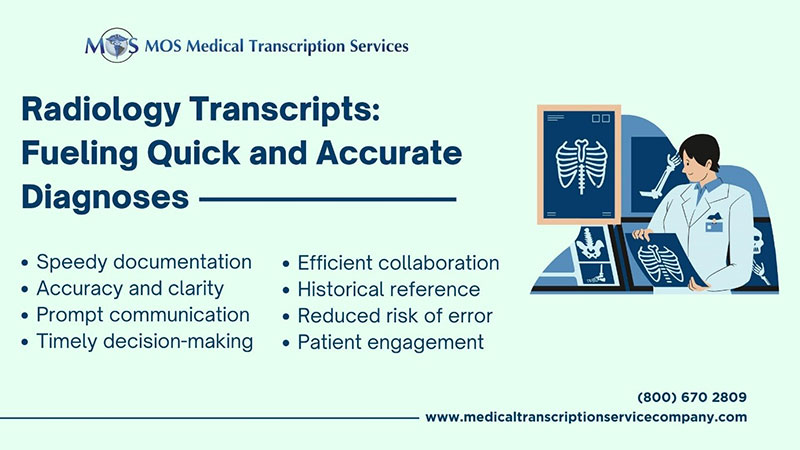
Radiology imaging techniques find extensive application across various healthcare specialties for diagnosing diseases and conditions. These diagnostic images necessitate interpretation by radiologists and subsequent transcription into precise radiology reports. These reports are then relayed to physicians to formulate treatment plans. In essence, radiologists and medical practitioners collaborate closely to decode imaging studies and convey the findings.
A radiology report may include Ultrasounds, Magnetic Resonance Imaging (MRI), X-Rays, Computer Tomography (CT), Mammograms, Position Emission Tomography (PET), Bone Scans, Consultations and Progress Notes, Nuclear Medicine, and many more. With accurate radiology transcription, many diseases can be identified at a very early stage. It helps providers in better understanding the patient’s condition and determining the appropriate treatment plan.

Radiology Transcription’s Impact on Timely Diagnosis
- Speedy documentation: Radiology transcription services ensure that the findings from imaging studies are promptly transcribed into detailed reports. This speed in documentation expedites the diagnostic process.
- Accuracy and clarity: Radiology transcripts provide a clear and accurate account of the radiologist’s observations, including the location, size, and characteristics of abnormalities or conditions. This precision is crucial for accurate diagnoses.
- Prompt communication: Transcribed reports can be quickly disseminated to referring physicians and specialists. This rapid communication enables healthcare providers to review findings and initiate appropriate treatment plans without delay.
- Timely decision-making: Early diagnosis often hinges on the ability of healthcare professionals to access and interpret radiology reports swiftly. Transcriptions make it easier for physicians to make timely decisions regarding further diagnostic tests, referrals, or treatments.
- Efficient collaboration: Transcripts serve as a foundation for interdisciplinary collaboration. Physicians from different specialties can review and discuss the findings collaboratively, enhancing the accuracy and speed of diagnosis.
- Historical reference: Radiology transcripts become part of a patient’s medical record, serving as historical references for future medical encounters. This continuity of information aids in tracking disease progression and treatment effectiveness over time.
- Reduced risk of error: Accurate transcription minimizes the risk of misinterpretation or miscommunication of critical diagnostic information, ensuring that the diagnostic process remains error-free.
- Patient engagement: Patients who receive clear and comprehensible radiology reports are better informed about their conditions. This engagement can prompt them to seek timely follow-up care and adhere to recommended treatment plans.
Outsourcing radiology transcription to an experienced medical transcription company offers numerous advantages to healthcare facilities and practices. It allows for the efficient and accurate conversion of radiology reports, ensuring a quick turnaround time and relieving in-house staff from the transcription workload. This leads to improved operational efficiency and cost savings as facilities can avoid the expenses associated with hiring and training dedicated transcription staff.


